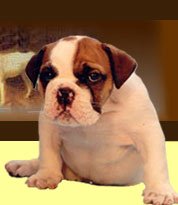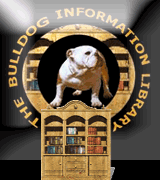The English Bulldog
Breed Standard
(part 2)
.
.
.
The flews, called the "chops" should be thick, broad, pendent, and very deep, hanging completely over the lower jaw at the sides (not in front). They should join the under lip in front and quite cover the teeth. The jaws should be broad, massive and square, the lower jaw should project in front of the upper and turn up (viewed from the side it should be basket-handle arched, called the turn-up).
detailed and explained by Catherine Marien
Complete with the latest official amendments,
September 2003 (in brown in the text)
flews, nose, ears, mouth and teeth
Viewed from the front, the various properties of the face must be equally balanced on either side of an imaginary line down the centre of the face.
Correct turp-up
with typical basket-handle
arched mandible
Incorrect turn-up
Mandible turns up
only at front which gives
the illusion of being correct
No turn-up
Long, straight, protruding
jawbone
(excessively undershot)
with exposed canines
Nose
The nose should be large, broad and black, and under no circumstances should it be liver coloured, red or brown; its top should be deeply set back almost between the eyes.
The flat of the nostril should not be vertical but should slope backwards. The distance from the inner corner of the eye (or from the centre of the stop between the eyes) to the extreme tip of the nose should not exceed the length from the tip of the nose to the edge of the under lip.
Eyes and eyelids
Seen from the front, the eyes should be situated low down in the skull, as far as possible from the ears. The eyes and "stop" should be in the same straight line, which should be at right
The nostrils should be large, wide, and black, with a well-defined vertical straight line between them. The nose roll must not interfere with the layback-line.
angles to the furrow. They should be as wide apart as possible, provided their outer corners are still within the outline of the cheeks, and of moderate size, neither deep-set nor protruding. Though the shape prescribed by the standard is quite round, the eyelids may often give a more almond look to the eyes. The eyes should be very dark - almost black.
Ears
The ears should be set as high as possible on the head AND at the same time as wide apart as possible, and as high and as far from the eyes as possible. Thus, viewed from the front, the front inner edge of each ear should join the outline of the skull at the top corner of such outline. In size they should be small and thin. The shape termed "rose ear" is correct, and folds inwards at its back, the upper or front edge curving over outwards and backwards, showing part of the inside of the burr.
The eyelids should cover the white of the eye when the dog is looking directly forward and should be free of obvious eye problems.
Faulty, low-set ears
lop-eared
Correct "rose" ears, level with skull
Mouth and teeth
The jaws should be broad and square and have the six small front teeth between the canines aligned in an even row (the canines and incisors on the same straight line).
Button ears,
with typical
forward carriage
most prevalent
type of faulty ears
Flap-eared,
poor carriage,
common fault with
large, tick ears
not to be confused
with button ears
(no forward carriage)
Erect ears
or bat ears,
with broad base
and facing forward,
nowadays a
very rare fault
Tulip ears,
common among
the early
bull-baiting bulldogs
Correct undershot, slightly
prognathous because of
turn-up also called 'reverse
scissors bite'
Incorrect,
retruded, also called
overshot, overbite or
parrot mouth
The canine teeth are wide apart. The teeth should not be seen when the mouth is closed. The teeth should be large and strong. When viewed from the front, the under jaw should be centered under the upper jaw to which it should also be parallel.
Incorrect,
too prognathous common error in the Bulldog
Incorrect,
level bite, the upper and lower teeth meet each other edge to edge.
Scissors bite, incorrect in Bulldogs, but normal bite in most dog breeds
Original idea, design and development by C. Marien-de Luca. No part of bulldoginformation.com may be copied, distributed, printed or reproduced on another website without the owner's written permission. Please feel free to link from your site to any of the pages on this website in a non-frame presentation only.










